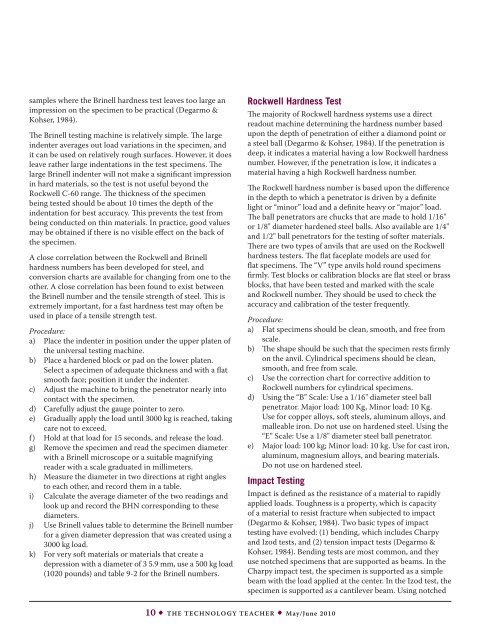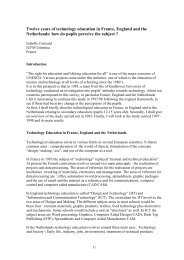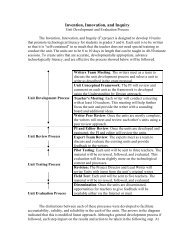May/June - Vol 69, No 8 - International Technology and Engineering ...
May/June - Vol 69, No 8 - International Technology and Engineering ...
May/June - Vol 69, No 8 - International Technology and Engineering ...
You also want an ePaper? Increase the reach of your titles
YUMPU automatically turns print PDFs into web optimized ePapers that Google loves.
samples where the Brinell hardness test leaves too large an<br />
impression on the specimen to be practical (Degarmo &<br />
Kohser, 1984).<br />
The Brinell testing machine is relatively simple. The large<br />
indenter averages out load variations in the specimen, <strong>and</strong><br />
it can be used on relatively rough surfaces. However, it does<br />
leave rather large indentations in the test specimens. The<br />
large Brinell indenter will not make a significant impression<br />
in hard materials, so the test is not useful beyond the<br />
Rockwell C-60 range. The thickness of the specimen<br />
being tested should be about 10 times the depth of the<br />
indentation for best accuracy. This prevents the test from<br />
being conducted on thin materials. In practice, good values<br />
may be obtained if there is no visible effect on the back of<br />
the specimen.<br />
A close correlation between the Rockwell <strong>and</strong> Brinell<br />
hardness numbers has been developed for steel, <strong>and</strong><br />
conversion charts are available for changing from one to the<br />
other. A close correlation has been found to exist between<br />
the Brinell number <strong>and</strong> the tensile strength of steel. This is<br />
extremely important, for a fast hardness test may often be<br />
used in place of a tensile strength test.<br />
Procedure:<br />
a) Place the indenter in position under the upper platen of<br />
the universal testing machine.<br />
b) Place a hardened block or pad on the lower platen.<br />
Select a specimen of adequate thickness <strong>and</strong> with a flat<br />
smooth face; position it under the indenter.<br />
c) Adjust the machine to bring the penetrator nearly into<br />
contact with the specimen.<br />
d) Carefully adjust the gauge pointer to zero.<br />
e) Gradually apply the load until 3000 kg is reached, taking<br />
care not to exceed.<br />
f) Hold at that load for 15 seconds, <strong>and</strong> release the load.<br />
g) Remove the specimen <strong>and</strong> read the specimen diameter<br />
with a Brinell microscope or a suitable magnifying<br />
reader with a scale graduated in millimeters.<br />
h) Measure the diameter in two directions at right angles<br />
to each other, <strong>and</strong> record them in a table.<br />
i) Calculate the average diameter of the two readings <strong>and</strong><br />
look up <strong>and</strong> record the BHN corresponding to these<br />
diameters.<br />
j) Use Brinell values table to determine the Brinell number<br />
for a given diameter depression that was created using a<br />
3000 kg load.<br />
k) For very soft materials or materials that create a<br />
depression with a diameter of 3 5.9 mm, use a 500 kg load<br />
(1020 pounds) <strong>and</strong> table 9-2 for the Brinell numbers.<br />
Rockwell Hardness Test<br />
The majority of Rockwell hardness systems use a direct<br />
readout machine determining the hardness number based<br />
upon the depth of penetration of either a diamond point or<br />
a steel ball (Degarmo & Kohser, 1984). If the penetration is<br />
deep, it indicates a material having a low Rockwell hardness<br />
number. However, if the penetration is low, it indicates a<br />
material having a high Rockwell hardness number.<br />
The Rockwell hardness number is based upon the difference<br />
in the depth to which a penetrator is driven by a definite<br />
light or “minor” load <strong>and</strong> a definite heavy or “major” load.<br />
The ball penetrators are chucks that are made to hold 1/16"<br />
or 1/8" diameter hardened steel balls. Also available are 1/4"<br />
<strong>and</strong> 1/2" ball penetrators for the testing of softer materials.<br />
There are two types of anvils that are used on the Rockwell<br />
hardness testers. The flat faceplate models are used for<br />
flat specimens. The “V” type anvils hold round specimens<br />
firmly. Test blocks or calibration blocks are flat steel or brass<br />
blocks, that have been tested <strong>and</strong> marked with the scale<br />
<strong>and</strong> Rockwell number. They should be used to check the<br />
accuracy <strong>and</strong> calibration of the tester frequently.<br />
Procedure:<br />
a) Flat specimens should be clean, smooth, <strong>and</strong> free from<br />
scale.<br />
b) The shape should be such that the specimen rests firmly<br />
on the anvil. Cylindrical specimens should be clean,<br />
smooth, <strong>and</strong> free from scale.<br />
c) Use the correction chart for corrective addition to<br />
Rockwell numbers for cylindrical specimens.<br />
d) Using the “B” Scale: Use a 1/16" diameter steel ball<br />
penetrator. Major load: 100 Kg, Minor load: 10 Kg.<br />
Use for copper alloys, soft steels, aluminum alloys, <strong>and</strong><br />
malleable iron. Do not use on hardened steel. Using the<br />
“E” Scale: Use a 1/8" diameter steel ball penetrator.<br />
e) Major load: 100 kg; Minor load: 10 kg. Use for cast iron,<br />
aluminum, magnesium alloys, <strong>and</strong> bearing materials.<br />
Do not use on hardened steel.<br />
Impact Testing<br />
Impact is defined as the resistance of a material to rapidly<br />
applied loads. Toughness is a property, which is capacity<br />
of a material to resist fracture when subjected to impact<br />
(Degarmo & Kohser, 1984). Two basic types of impact<br />
testing have evolved: (1) bending, which includes Charpy<br />
<strong>and</strong> Izod tests, <strong>and</strong> (2) tension impact tests (Degarmo &<br />
Kohser, 1984). Bending tests are most common, <strong>and</strong> they<br />
use notched specimens that are supported as beams. In the<br />
Charpy impact test, the specimen is supported as a simple<br />
beam with the load applied at the center. In the Izod test, the<br />
specimen is supported as a cantilever beam. Using notched<br />
10 • The <strong>Technology</strong> Teacher • <strong>May</strong>/<strong>June</strong> 2010
















